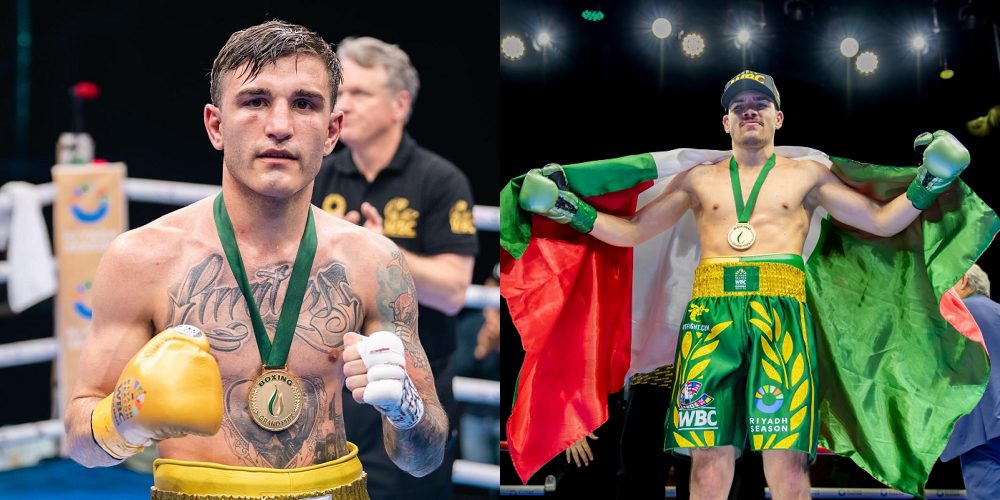As we approach the final stages of the Boxing Grand Prix, organized by the WBC with the support of Riyadh Season, the challenges for the fighters still in contention are becoming increasingly demanding. On Wednesday, August 13, our two standard-bearers Muhamet Qamili and Fiorenzo Priolo will have to give their very best to overcome their dangerous opponents, who will be, respectively, American Troy Nash and South African Ntethelelo Nkosi. In this piece, we will try to identify the most significant tactical aspects of the matches awaiting our two young talents.
Muhamet Qamili vs Troy Nash – Featherweight Quarterfinals
Troy Nash is only 20 years old, but he has already managed to capture the attention of the international press with his excellent performances in the Boxing Grand Prix. Just consider that WBC President Mauricio Sulaiman himself, at the end of the American’s round-of-16 victory, publicly stated: “We might be looking at the future star in boxing.”
Nash is a tall and lanky fighter, boasting significant height and reach for the featherweight division, standing at 175 centimeters. His main strengths are his timing and hand speed: the American snaps his upper limbs like two whips, stopping his opponent’s initiative at the outset with sharp, sudden punches, relying mainly on the jab and the straight right.
Although his victories in the first two rounds of the tournament were impressive and unquestionable, it should be noted that both of his opponents made things easier for him by fighting on the terrain most favorable to him. Both Alexander Kovrigin and Zholdas Zhengissov allowed him to maintain long range for much of the fight.
To drag his opponent out of his comfort zone, Qamili will have to rely on his superior experience. Our athlete has fought more than three times as many professional bouts as the American, is five years older, and has therefore faced a greater variety of tactical situations inside the ropes.
A good example of how Nash can be taken into deep, uncharted waters can be found in the sixth and final round of his fight against Kovrigin. Aware that his deficit on the scorecards was now insurmountable, the Kazakh fighter put on his battle helmet and launched a relentless body attack, winning the round on all three official cards.
Qamili has shown on several occasions that he is a versatile fighter, capable of performing effectively even in close-range exchanges. To maximize his chances of success, on Wednesday the pupil of Alessandro Elmoety will have to impose an inside fight on Nash, minimizing the height gap as much as possible, working both upstairs and downstairs, thus creating a rough, high-intensity battle.
Also worth noting is a flaw in Troy Nash’s game that many may have overlooked: the American often tends to dangerously lower his left arm, especially when feinting an attack. A sort of “tic” that could have dire consequences for him if Qamili’s right hand is launched at the right moment…
Fiorenzo Priolo vs Ntethelelo Nkosi – Super Lightweight Quarterfinals
The easiest prediction to make about this fight is that we’ll see a contest with hardly a moment’s pause. Both boxers involved have an incessant work rate as one of their most distinctive strengths, so it’s highly likely that on Wednesday they won’t stop throwing punches like madmen for six consecutive rounds.
Nkosi is a short, stocky, and muscular fighter, used to facing taller, rangier opponents and therefore accustomed to closing the gap to unleash his offensive arsenal. The South African doesn’t possess flawless technique, and many of his punches follow rather unorthodox trajectories, but he’s a tough, tireless athlete – the very definition of a pressure fighter.
In the opening round of the tournament, he easily got the better of Egypt’s Madboly in three rounds, in a bout that proved of little significance given the modest level of his opponent. Far more telling was his round-of-16 clash against China’s Ju Wu, which the South African won by unanimous decision after rallying back.
Thanks to his mobility and southpaw stance, Wu managed to cope well in the first two rounds, pulling ahead on two of the official scorecards, but in doing so he burned through enormous amounts of energy to keep Nkosi at bay. Taking advantage of the Chinese fighter’s lack of power, Nkosi was able to turn the tide of the fight with relentless pressure, completely wearing his opponent down and dominating the last two rounds.
Fortunately, Priolo is a fighter whose stamina is one of his biggest assets. The Piedmont native always shows excellent conditioning when he steps into the ring, and in this case that could prove crucial. Just as important will be the tactical approach, which is by no means an obvious choice.
On one hand, trading with Nkosi in the center of the ring, chest-to-chest, would mean giving up his height advantage and making it easier for the South African to land his trademark hooks. On the other, constantly moving to avoid a brawl could prove too exhausting in the long run and would give Nkosi the space he needs for his frontal assaults.
As Aristotle said, “Virtue lies in the middle.” Priolo will need to focus on the mid-range, getting his longer arms to land first, smothering the opponent’s close-range strength with a bit of ring craft, and then quickly moving back into his ideal range without being pushed around the ring. Easier said than done, of course, but the excellent performances delivered by our fighter in the first two rounds of the tournament, along with his willingness to diligently follow the advice of his coach Cristian De Martinis, are encouraging signs.

